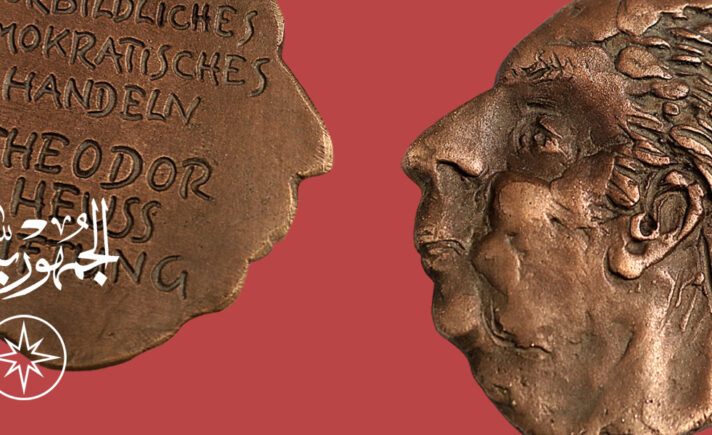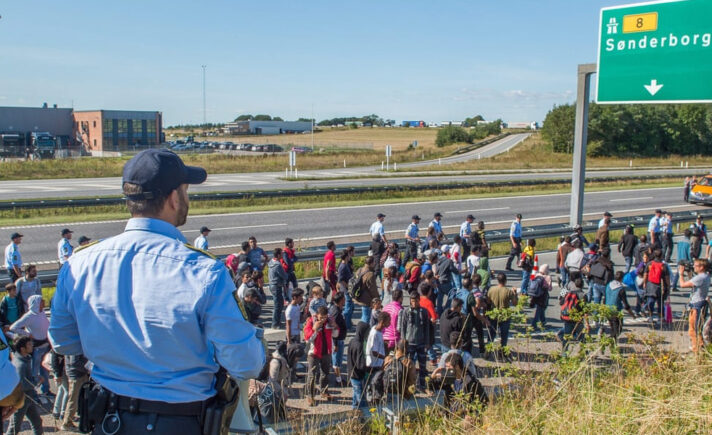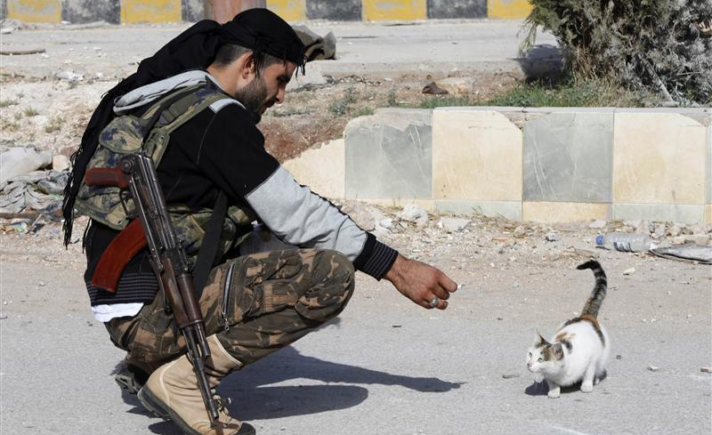“If the Party could thrust its hand into the past and say of this or that event, it never happened—that, surely, was more terrifying than mere torture and death.”
– George Orwell, Nineteen Eighty-Four
In June 2016, when the world’s attention was turned to the Assad regime’s final assault on besieged Aleppo and the dwindling fortunes of the Islamic State (ISIS), a new NGO called the Watan Document Foundation was founded in Damascus by a certain Dr. Bouthaina Shaaban. The NGO’s goal was “oral documentation with the aim of preserving and documenting the national memory” of the Syrian conflict, Shaaban stated in an interview. According to its slick-looking website, the WDF “strives to preserve the eyewitness’ [sic] contemporary national memory and protect it from loss, distortion or fraud” by creating an oral history archive, documenting a range of relevant topics, and writing a contemporary history of the Syrian war:
The war on Syria has deeply affected Syrian society at all levels. The documentation of this war through the testimonies of people and their suffering will form the history of this stage. This will be carried out depending on a national effort and according to a scientific approach, so that these documents become a historical reference for researchers and future generations with the purpose of preventing others from writing our own history according to their own interests.
“The Project of Documenting the War on Syria” (28 June 2018), at: http://en.wathiqat-wattan.org/452/the-project-of-documenting-the-war-on-syria and http://en.wathiqat-wattan.org/category/oral-history [accessed 22 May 2019]
Shaaban, a long-time foreign policy and media advisor to both Hafez and Bashar al-Assad, holds a PhD in English literature from the University of Warwick, and has worked for many years as a professor at the Department of English at Damascus University. She is the author of several books, including a set of interviews with Syrian women about their lives and the roles of women in Syrian history and society.
Narrative wars
First and foremost, it must be recognized that “narrative wars” are not an abnormal process during and after violent conflicts, including wars and genocides. Nor are they limited to the “post-truth” era, because states have denied and obfuscated their crimes such as mass murder throughout history. In 1915, the Young Turk regime staged photos of “armed Armenian banditry” by hauling in terrified Armenian prisoners behind a stack of weapons (probably from the Ottomans’ own depots), and taking photos that to this day are used to deny the Armenian Genocide.
Indeed, Shaaban’s initiative is not unique in the history of state-sponsored mass murder. She has now joined the pantheon of denialist state intellectuals whose sole purpose is the moral neutralization and contortion of the historical record of their own state’s violence. Her counterparts are such people as Dr. Yusuf Halaçoğlu, who spent entire decades of his life singularly obsessed with producing denial of the Armenian Genocide. Not only was he the long-time director of the Turkish Historical Association, which churned out screed after screed of denial and distortion, but was also a member of parliament with the openly fascist Nationalist Action Party.
Fortunately, in the Syrian case, there are a number of excellent initiatives as well, including but not limited to: the Syrian Archive; the Zakera Project; the Umam Documentation and Research Centre; the Syrian Prints newspaper archive; and various oral history projects launched, for example, by the International Coalition of Sites of Conscience; Badael; and the NIOD Institute.
Formulating a research agenda for Syria
In order to circumvent the pitfalls of narrative wars, it is vital to formulate a research agenda or program for likely contestation and research. This vision must address two substantial issues of truth-making: fact-finding and interpretation. First, the “fog of war,” intentional blurring, and contestation of factual events that have occurred requires a rigorous examination of those events and a clear separation between fact and fiction, to the best extent possible. Second, all historical events are subject to honest interpretation, and the Syrian conflict is no exception. A better understanding of this often confusing or misrepresented conflict also requires a set of legitimate, grounded interpretations that will clarify the causes, courses, and consequences of the conflict. The potential components of a rigorous research agenda outlined below are intended as suggestions, not an exhaustive list, but due to their relevance and complexity, they could even be tackled as separate studies.
Factual issues: what happened, and how did it happen?
- Numbers: how many died? First and foremost, as in all wars, the numbers of dead and wounded need to be clarified. Major actors like the UN and the Violations Documentation Center have basically given up on pursuing a precise body count because of the difficulties of research inside the country. But we need to know how many people died in total, how many of them were clearly combatants, how many clearly civilians, and under which conditions they met their end.
- Beginning: how did it begin? The revolution “started” in Daraa, it is commonly said, but the precise circumstances are shrouded in uncertainty, partly because of the regime’s secrecy, but also because it became the foundational myth of the revolution. We need a precise accounting for the story of the children, their motives, their torture, what the local security chief Atef Najib precisely said and did to them, the ensuing protests, and the regime assault and siege of Daraa.
- Escalation: how did it escalate? A number of critical events must be understood if we want to understand the escalation of the conflict. For example, the 18 July, 2012, bombing of the National Security headquarters in Damascus, which killed a dozen top security officials, is fundamentally contested: perhaps it was the rebels, perhaps it was regime hardliners, but transparency is needed. Similarly, the Free Syrian Army’s entrance into Aleppo in Ramadan 2012 is widely seen as a major escalation, but what exactly transpired in the initial period of Aleppo’s revolution?
- Nadir: who committed the massacres? As the violence intensified, so did the propaganda wars. We need full and complete accountings of massacres such as in Homs city (early 2012) and Houla (25 May, 2012), and the chemical attacks in Eastern Ghouta (21 August, 2013). Whereas the identities of the victims and the conditions of these massacres are fairly well-known, about the perpetrators we are still largely in the dark. The power of the regime and the vested interests of its backers have precluded good-faith, focused studies of these massacres.
- Control: who controlled what? The notion that the conflict was “chaotic” and “unpredictable” is a lazy cliché, as it is very possible to establish levels of control, if only the right questions are asked and the right files are examined. How much control did Bashar al-Assad exercise over the course of events? We need to understand, unequivocally, the chains of command that exist(ed)over territories and jurisdictions in the country.
- Collusion: who colluded with ISIS? The Assad regime’s infiltration of and collusion with ISIS has been hinted at in various publications and testimonies. In one of my own interviews, a well-connected Alawite man confirmed that he witnessed a middle-aged, Salafi-looking agent walk into an intelligence office in Tartous and openly discuss his secret placement as an amir (commander) in ISIS. But the full extent to which the regime embedded moles in the caliphate’s security apparatus and steered its actions is unknown.
Interpretation: why did it happen, and how did it develop?
- Causes: Why did the conflict begin? The Syrian conflict has been explained through a staggering number of factors and causes, from the environmental to the geopolitical, sectarian, cultural, historical, political-economic, conspiratorial and even eschatological. Yet a solid, non-judgmental, multi-dimensional examination of its causes requires a broad range of academic disciplines to think about causality; both as deeper, long-term causes, and short, immediate triggers.
- Motives: Why did Syrians get involved in the conflict? Syrians’ own agency is a deeply complex affair. Why did people fight, with whom, and why with them? Why did they not fight? How can we explain the strategic and tactical decisions of the fighting factions? Motives are a complex affair that can be a mix of private and political stimuli that change over time.
- Sectarianism: What was the locus of sectarianism in the conflict? The notion that sectarianism was not a cause of the violence, but a consequence, is a common truism, but it needs to be explored better. Extreme constructivism (“Syrians are not sectarian, it is all imagined”) is just as unhelpful in understanding the problem as essentialism (“it is all because of Syrians’ profound sectarianism”). Research into sectarianization needs to explain the concept and discuss how it influenced people.
- Foreign involvement: What was the role of foreign intervention, covert and overt, in the conflict? This is the material of spy novels, and for precisely this reason needs to be critically examined, for Syria’s direct neighbors, the MENA region, and ultimately also globally. How did the proxy war come about? What was the role of humanitarian interventionism, the Iraq war, the Obama doctrine? What were the precise reasons, goals, and extent of Iranian and Russian intervention? Did Turkey collude with ISIS, and if so, how, and why? And many other questions remain open.
- Mukhabarat: How did the regime’s secretive intelligence agencies (mukhabarat) influence the conflict? Two immensely impactful actors that have been consistently unresearchable throughout the conflict are the mukhabarat and ISIS. Whereas many books have been written on ISIS, we know next to nothing about Assad’s machinery of extermination. The dilemma is that the mukhabarat’s profound influence is matched only by its extreme secrecy: it has steered and structured the conflict like a hidden hand, but only sound analyses can uncover the veil of mystery.
- Imprisonment: How does the Syrian prison system function? The number of Syrians who at some point have spent time in a prison must run into the hundreds of thousands. Imprisonment has characterized the conflict more than any other form of violence, but apart from some memoirs and sketches here and there, there are no good studies of the intricacies of Syria’s prison system. The subject is clearly related to the previous one, and fortunately research is underway. (Together with Jaber Bakr, the author is preparing an overview book on the Syrian prison system.)
These and many other large, factual, and interpretive issues are not driven by a legal, political, or moral agenda, but by one that serves the historical record, and therefore should be top priority for researchers. The regime has long obstructed truth-finding with regards to many of these issues, and we can be sure that it will continue to do so—with support from the WDF and others. But if the perpetrators can stick to their guns, we can stick to ours.
Conclusion: the truth shall set us free
The Syrian conflict is one of the most contested conflicts in history. Ideological and geopolitical biases have prevented a complex picture from being sketched, and produced too many one-sided narratives. But neither fact-finding nor interpretation is a black-and-white affair. The complexity and ambivalence of the conflict can be found in a broad range of topics, such the many inconvenient and politically inexpedient forms of violence. For example, the Assad regime claimed to fight for Palestine, but has killed more Palestinians than Israel by a long stretch. On many occasions throughout the conflict, the regime sent the army into loyalist areas, not to fight the rebels, but to stop its own irregular militiamen (shabbiha) from looting. The regime claimed to combat terrorism, but until 2011 was working hand in glove with those same al-Qaeda fighters it had sent to Iraq, who, only a few years later, as hardened fighters would set up Jabhat al-Nusra and wreak havoc on loyalist neighborhoods.
And the regime is hardly the only actor with such inconsistencies to explain. The Kurdish People’s Protection Units (YPG), which claimed to champion Kurdish rights, were involved in the suppression of other Kurdish social and political movements in Rojava/Jazeera. ISIS purported to fight with Sunni Muslims against the “apostates” of the regime, but it sold oil to that same regime and executed Sunnis as “spies” on the most spurious of pretexts. The revolution, too, had to grapple with some embarrassing events: many Aleppo revolutionaries who supported the charismatic rebel commander Abdelqader Saleh were shocked when they realized that rural class resentment drove his Tawhid Brigade to loot upscale areas of Aleppo on a massive scale. And what to say about Syria’s entangled histories? The many mixed marriages and multi-sectarian families (Sunni/Shia, Christian/Muslim) that fell apart? Or those tribes in eastern Syria that first worked with the regime, then with ISIS, then with the Kurdish-led SDF, and then again with the regime? Obviously, no conflict is black and white, but it is these types of greyscales that offer a deeper understanding of Syria’s dynamics. We need a patient, meticulous analysis of these situations and processes, steering clear of moralist, dichotomous portrayals.
The Syrian cataclysm needs a broad-based research program that addresses all of these issues, and more, so that we gain lucidity and combat denial and distortion. Not for the sake of advocacy, but for the sake of truth.






